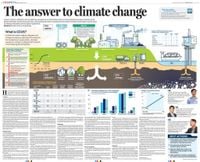On August 29, 2025, a wave of controversy swept across the United States as the federal government, under President Donald Trump, dramatically pulled the plug on nearly $1.4 billion in support for offshore wind energy projects. At the same time, grassroots climate activists took to the streets—and bridges—to make their voices heard, underscoring the deepening divide over America’s energy future.
The U.S. Transportation Department announced the cancellation of $679 million in federal funding for a dozen offshore wind projects spanning 11 states. Among the casualties: a $435 million investment earmarked for a floating wind farm in Northern California and $47 million intended to boost a Maryland offshore wind initiative. According to Associated Press, the department said the rescinded funds would be redirected to upgrade ports and other infrastructure, wherever possible.
Transportation Secretary Sean Duffy left little doubt about the administration’s stance. “Wasteful, wind projects are using resources that could otherwise go towards revitalizing America’s maritime industry,” Duffy declared, adding, “Thanks to President Trump, we are prioritizing real infrastructure improvements over fantasy wind projects that cost much and offer little.”
The move, however, was just the latest in a string of actions targeting renewable energy. On the very same day, the Department of Energy withdrew a $716 million loan guarantee approved during the Biden administration for a New Jersey offshore wind project. And just a week earlier, construction was abruptly halted on the nearly completed $4 billion Revolution Wind project off the coasts of Rhode Island and Connecticut—a project that was expected to generate enough power for more than 350,000 homes in the region.
The official rationale for halting Revolution Wind, according to the Interior Department, was the need to review the project and address unspecified national security concerns. Yet, for many Democratic officials and labor leaders, the explanation rang hollow. Rhode Island Governor Dan McKee minced no words: “It’s an attack on our jobs. It’s an attack on our energy. It’s an attack on our families and their ability to pay the bills.”
Patrick Crowley, president of the Rhode Island AFL-CIO, echoed the frustration, vowing, “We’re going to fight (Trump) every step of the way, no matter how long it takes.”
These cancellations have sent shockwaves through the renewable energy sector, which had seen a surge in support under the Biden administration. In December 2022, the U.S. held its first-ever auction of leases for floating wind farms, a move hailed by clean energy advocates as a milestone for harnessing the deep waters off the West Coast. Floating wind technology, they argue, is essential for tapping into the vast wind resources far from shore—areas where traditional, seabed-anchored turbines simply won’t work.
Yet, President Trump has made no secret of his skepticism toward wind and solar power. He has consistently derided wind turbines as “ugly and expensive,” and, earlier this month, doubled down on his opposition, declaring on social media that wind and solar energy are “THE SCAM OF THE CENTURY!” At a Cabinet meeting, he stated, “We’re not allowing any windmills to go up unless there’s a legal situation where somebody committed to it a long time ago.”
Trump’s administration has justified its actions by pointing to rising energy prices, blaming renewables for the increase. However, as Associated Press reports, energy analysts have noted that renewable sources have little to do with recent price hikes. Instead, the culprits are surging demand from artificial intelligence and energy-hungry data centers, aging infrastructure, and ever-more-extreme weather events—many of which are exacerbated by climate change itself.
For communities on the front lines of these policy shifts, the stakes are high. Revolution Wind, developed by Danish energy company Orsted, was seen as a linchpin for Rhode Island and Connecticut’s transition to clean energy. Now, Orsted is assessing the financial fallout and weighing possible legal action in response to the construction halt. Democratic officials warn that missing out on the renewable power from Revolution Wind could not only jeopardize state climate goals but also drive up electricity prices throughout the region.
The administration’s stance has drawn fierce criticism from environmentalists and lawmakers alike. California Representative Jared Huffman, the top Democrat on the House Natural Resources Committee, called the funding cancellations “outrageous” and “deeply disappointing.” Huffman told Associated Press, “Trump and his Cabinet have a stubborn and mystifying hatred of clean energy. It’s so dogmatic. They are willing to eliminate thousands of jobs and an entire sector that can bring cheap, reliable power to American consumers.”
Meanwhile, the administration has not limited its efforts to the East and West Coasts. Earlier in August, the Interior Department canceled a major wind farm in Idaho that had been approved during the Biden administration. That project had drawn criticism for its proximity to a historic site where Japanese Americans were incarcerated during World War II, adding another layer of complexity to the debate.
Not everyone is mourning the loss of offshore wind projects. Supporters of fossil fuel development argue that the federal government should focus on “real infrastructure” and restoring U.S. “energy dominance” by ramping up coal, oil, and natural gas production. They point to job creation in traditional energy sectors and warn against what they see as wasteful spending on technologies that, in their view, have yet to prove themselves on a large scale.
But for many Americans, the battle over clean energy is not just about economics or aesthetics—it’s about the future of the planet. That sentiment was on vivid display on Cape Cod the same day the funding cuts were announced. The Red Rebel Brigade, a climate activist group known for its striking visual protests, crossed the Bourne Bridge in full mime, reaching out to cars and holding signs to raise awareness about environmental concerns. Photographs published by Cape Cod Times captured the scene: activists in red, faces painted, stretching out their arms to passing motorists, a silent but powerful reminder of the stakes in the climate fight. One image showed a truck gunning its exhaust as it passed the demonstrators, while another caught a passenger waving back in solidarity.
Nancy Kanwisher, an activist from Boston and Cape Cod, was among those holding signs near the Bourne state police barracks. The Red Rebel Brigade’s message was clear: the environment—and the policies that shape its future—matter to everyday Americans.
As the nation grapples with these competing visions for its energy future, one thing is certain: the debate is far from over. With billions of dollars and thousands of jobs on the line, and with the climate crisis looming ever larger, the choices made today will echo for generations.




